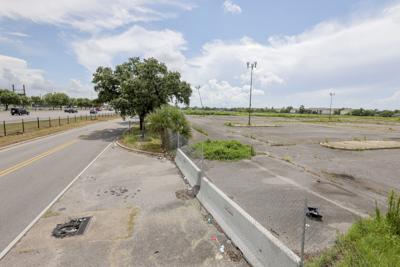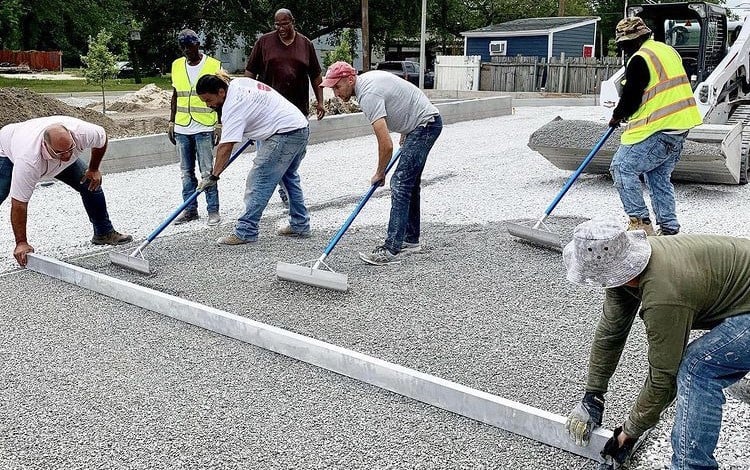 In recent times, stormwater management in New Orleans has been characterized by regularly overwhelmed drainage systems, excessive paving and pumping that has depleted groundwater levels and led to a sinking city, and urban water assets being wasted while hidden behind walls, underground, or pumped into the river and lake. All of these issues and the failure of traditional infrastructure (levees, pipes and pumps) to protect the city from Hurricane Katrina, continuous flooding, and subsidence has led to a shift in mindset regarding the most effective and thoughtful way to manage stormwater in South Louisiana. It is clear that the single-minded approach of rushing stormwater over pavement, into pipes and pumping it out of the city needs to be reevaluated.
In recent times, stormwater management in New Orleans has been characterized by regularly overwhelmed drainage systems, excessive paving and pumping that has depleted groundwater levels and led to a sinking city, and urban water assets being wasted while hidden behind walls, underground, or pumped into the river and lake. All of these issues and the failure of traditional infrastructure (levees, pipes and pumps) to protect the city from Hurricane Katrina, continuous flooding, and subsidence has led to a shift in mindset regarding the most effective and thoughtful way to manage stormwater in South Louisiana. It is clear that the single-minded approach of rushing stormwater over pavement, into pipes and pumping it out of the city needs to be reevaluated.
History
In September of 2013, Waggonner & Ball Architects released the Greater New Orleans Urban Water Plan. The plan was a result of the Dutch Dialogues and the culmination of the collaborative efforts of officials, professionals, advocates, and community members who began to question current practices while taking a serious look at the place of natural processes in the urban environment. The GNO Urban Water Plan called for a tandem approach to stormwater management that utilizes natural processes to decrease reliance on and take pressure off of grey infrastructure systems, while celebrating the region’s abundant water resources.
Local government contributed to large-scale green infrastructure implementation. In 2014, the Sewerage and Water Board of New Orleans funded seven initiatives whose focus was stormwater management and invested $500,000 a year until 2018 for a total of $2.5 million invested in green infrastructure projects. Article 23 of the Comprehensive Zoning Ordinance placed stormwater management requirements that emphasize BMP’s on all new commercial developments in Orleans Parish that are over 10,000 sq. ft.
In 2017, HUD awarded the City $141.2 million in Community Development Block Grant National Disaster Resilience grant funding for disaster resilience. New Orleans was one of only 13 jurisdictions out of 67 eligible applicants to be awarded funding from the NDRC and received the second largest amount nationally.
New Orleans’ winning proposal – Reshaping the Urban Delta – called for the creation of the city’s first comprehensive resilience district in Gentilly with projects that invest in innovative and creative solutions so that the people, culture and infrastructure can thrive. Unfortunately, little of the funding has been spent on implementation and the project has made little progress in the past 6 years.
We’re changing how we live with water
Natural processes slow, store and filter stormwater where it  falls, allowing it to return to the groundwater system. Nature-based solutions, or green infrastructure, include systems such as canals and waterways, rain gardens, permeable pavement, floating streets, retention ponds, constructed wetlands and other bioretention systems that slow, store and filter stormwater. Programs underway in cities such as Seattle, Portland and Philadelphia are prime examples of the potential held by these sorts of solutions.
falls, allowing it to return to the groundwater system. Nature-based solutions, or green infrastructure, include systems such as canals and waterways, rain gardens, permeable pavement, floating streets, retention ponds, constructed wetlands and other bioretention systems that slow, store and filter stormwater. Programs underway in cities such as Seattle, Portland and Philadelphia are prime examples of the potential held by these sorts of solutions.
Where we are today
Since the release of the UrbanWater Plan ten years ago, climate change has accelerated, requiring concerted efforts among all of Southeast Louisiana’s stakeholders to develop long-term solutions to our environmental challenges including increasingly erratic weather patterns that bring periods of extended heat, drought, as well as frequent inundations. In New Orleans many firms, nonprofit organizations, and city agencies are working to develop innovative and impactful responses:
- Community-based non-profits and workforce training programs including the Urban Conservancy, Water Wise Gulf South, Louisiana Green Corps, Civic Studios, and Groundwork New Orleans are working to educate public officials, workforce trainees, teachers, children, property owners, and others. Through education and support, we are empowering residents to install and maintain green infrastructure throughout New Orleans. The GNO Urban Water Collaborative is spearheading the Water Justice Fund campaign, which advocates for a community-driven response to our drainage issues, funded through a citywide stormwater fee.
- City departments and agencies are stepping up, too. The Sewerage and Water Board of New Orleans is exploring sustainable, equitable approaches to funding New Orleans’ drainage system. The Office of Resilience and Sustainability is leading efforts to develop a comprehensive Stormwater Management Master Plan for the city. And the Department of Public Works has just launched a $10M effort to clear debris from 6500 catch basins.
- Private firms including Waggonner & Ball, Evans & Lighter, Dana Brown & Associates, Batture Engineering, Marais Consultants and Mastodonte are working to transform both the public and private domain through innovative stormwater design practices.
- In 2023, ten years after the release of the Greater New Orleans Urban Water Plan and the launch of the Urban Water Series, the Greater New Orleans Foundation, Greater New Orleans, Inc., and the Tulane ByWater Institute organized Urban Water @ 10 to activate regional stakeholders and advance the next decade of Urban Water Plan implementation. Urban Water @ 10 convened a wide array of diverse perspectives to assess progress, identify challenges, and develop priorities for collective impact to continue implementing the vision for living with water in the region. Through engaged activities and facilitated conversations that involved hundreds of stakeholders, ten priorities for action have risen to the surface including a much-needed overhaul of “government structures to support action and implementation,” as evidenced by the lack of progress with the $141M Gentilly Resilience District project.
Supporting sustainable stormwater management and climate resilience in New Orleans can be achieved through investments in the people who design, install, maintain, and monitor large scale infrastructure on public spaces and small scale interventions on private properties, and in developing project management and procurement systems that enable small green sector businesses to prosper and grow.
Learn more about the the Urban Conservancy’s current contributions to these efforts at BASIN and FYI.


 Photo credit: Thrive Works Green
Photo credit: Thrive Works Green